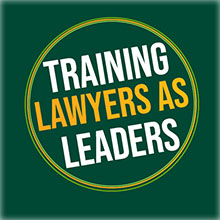By Caleb Bortner, Baylor Law Student
Friends,
As part of our leadership development class at Baylor Law, one of the assignments over the quarter is to read a book about leadership. Our definition of what constitutes a leadership book is broad for this purpose, so our students choose a wide variety of books, ranging from “leadership lite” (as Deborah Rhode called it) to biographies of famous leaders. The task to complete the assignment is for the students to write a short review covering the book and why someone who is interested in leadership might want to read it. So, we hope you enjoy Caleb Bortner’s review of Lead Yourself First: Inspiring Leaders Through Solitude by Raymond M. Kethledge and Michael S. Erwin.
– Stephen Rispoli

In a time when most of us are alone, due to Covid-19, how can we use this solitude to benefit ourselves and our society? I chose “Lead Yourself First” because the idea of isolation strikes me as something many of us are coping with right now. So how do we turn this “negative” into a positive force in our lives? How can we harness this unfortunate life event into something positive for us all?
Throughout history, leaders have used solitude as a sort of galvanizing tool to solve problems. Leaders have used solitude to bring focus without the constant background noise. Solitude brings out your natural intuition. It brings self-awareness or introspection in a way that would be impossible when surrounded by those you are leading. Time alone allows leaders to strengthen themselves using their faith or own inner strength and look at a problem from a different viewpoint. “Lead Yourself First” explored how many historical figures used solitude as a tool to create solutions.
Whether it was Ulysses S. Grant’s solitude in his tent after sickness, or Aung San Suu Kyi’s time imprisoned, or Martin Luther King Jr.’s imprisonment in Birmingham, leaders have found that time away from everyone allowed them to think. This opportunity to think, and to think deeply, allowed them to utilize the tools that made them great leaders in the first place. For Martin Luther King Jr., it galvanized his faith and resilience to keep fighting against systemic racism. Solitude gave Jane Goodall a chance to think deeply about chimpanzees and intuit a way to study them more closely. Solitude allowed Marie Curie the chance to intuit innovative experimentation techniques and conduct groundbreaking research.
In addition to the informative historical examples throughout “Lead Yourself First,” there were also stories of leaders in society today and examples of how solitude helped them. Frequently, Kethledge and Erwin focused on running as a mechanism for solitude. Not only does running create space between yourself and others, but it is also a way many people use to think through problems they are facing. Often, if stuck in a rut when you are writing or stuck with a problem, a piece of advice people will give you is to go for a walk. There is a reason for this; it allows you to place space between yourself and the problem and will enable you to think more deeply than you would if you were distracted by the electronics in your home.
Kethledge and Erwin end their book with straightforward advice about solitude and its benefits. They say that solitude works because it allows you to embrace hard thinking. It will not work if you use solitude to think on a superficial level or review old emails on the subject. Take solitude for the gift that it is. Close your office door, spread out all the documents on the matter, or allow yourself to look at your problem on a macro level and think about it from every angle you can. Kethledge and Erwin encouraged blocking off time to engage in hard thinking and solitude. They warned to use this time wisely to engage and embrace hard thinking and not just a superficial review of the issue at hand.
I would recommend this book to anyone struggling with the forced alone time we all have right now due to Covid-19. It helped me refocus my energy when I put into context all the forced solitude leaders from history have endured. They were all pillars of strength and used their time alone to create something extraordinary. I think we can all take notes from history and from “Lead Yourself First” to make our time in quarantine the most useful that we can.
– CALEB BORTNER





